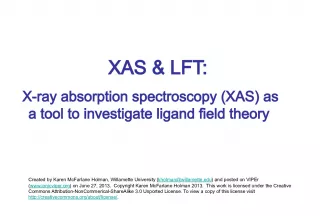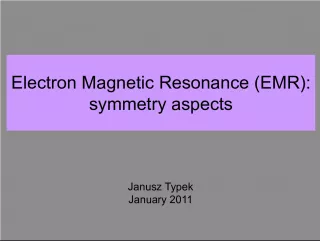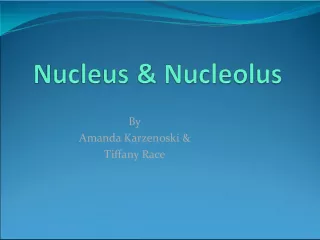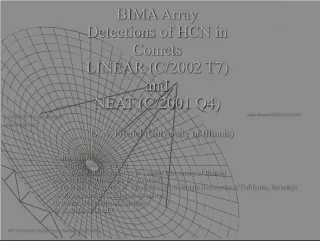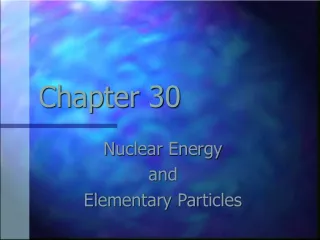Isomer Spectroscopy in Near Spherical Nuclei


This lecture discusses the concepts of isomers in near spherical nuclei and covers various topics such as electromagnetic transition rates, shell structure, odd A singly magic nuclei, seniority isomers, magnetic properties, and more. The lecture was presented by Paddy Regan at the School cum Workshop on Yrast and Near Yrast Spectroscopy held at IIT Roorkee in October 2009.
- Uploaded on | 0 Views
-
 noaneal
noaneal
About Isomer Spectroscopy in Near Spherical Nuclei
PowerPoint presentation about 'Isomer Spectroscopy in Near Spherical Nuclei'. This presentation describes the topic on This lecture discusses the concepts of isomers in near spherical nuclei and covers various topics such as electromagnetic transition rates, shell structure, odd A singly magic nuclei, seniority isomers, magnetic properties, and more. The lecture was presented by Paddy Regan at the School cum Workshop on Yrast and Near Yrast Spectroscopy held at IIT Roorkee in October 2009.. The key topics included in this slideshow are isomer spectroscopy, near spherical nuclei, electromagnetic transition rates, seniority isomers, magnetic properties,. Download this presentation absolutely free.
Presentation Transcript
1. Isomer Spectroscopy in Near-Spherical Nuclei Lecture at the School cum Workshop on Yrast and Near-Yrast Spectroscopy IIT Roorkee, October 2009 Paddy Regan Department of Physics University of Surrey Guildford GU2 7XH
2. Outline What is an isomer ? Electromagnetic transition rates. Weisskopf Single-Particle Estimates Shell Structure in near spherical nuclei. Odd-A singly magic nuclei (e.g., 205 Au 126 ) Why are E1s naturally hindered ? Seniority isomers, j 2 & j n configurations ? Near Magic nuclei. Limited valence space? Core breaking? Magnetic properties: g-factors in seniority isomers.
4. What is an isomer ? Why/when do nuclear isomers occur ? (i) large change in spin (spin-trap) (ii) small transition energy between states (seniority isomers) (iii) dramatic change in structure/shape (fission isomers) and/or underlying symmetry ( K -isomers) What information do isomers gives you ? Isomers occur due to single particle structure . For example, transitions are hindered between states with different structures (note, this is not case for seniority isomers). Metastable (long-lived) nuclear excited state. Long-lived could mean: ~10 -19 seconds, shape isomers in a-cluster resonances or ~10 15 years 180 Ta 9 - 1 + decay.
5. High-spin and -decaying isomers just above 208 Pb, basically as a result of yrast (spin) traps.. 9/2 + 11/2 + (13/2 + ) 99.984% -decay branch, 91% to 13/2 + isomer in 207 Pb, 7% to 1/2 - ground state in 207 Pb, Q ~ 9 MeV per decay 0 687 1065 1428 (17/2 + ) 1462 (25/2 + ) 211 Po T 1/2 =25secs T 1/2 =0.5 secs 0 115 238 1 - 2 - 0 - 9 - 250 T 1/2 = 61 min T 1/2 = 25 min - branch =33% branch = 67% 212 Bi 212 Bi, Z=83, N=129, 9 - from vg 9/2 x h 9/2 Yrastness is what causes these isomersthey simply have nowhere to go to (easily). This yrastness is itself caused by high-j intruders in the nuclear single particle spectrum.
6. E x >1MeV, T 1/2 >1ms (red) , T 1/2 >1hour (black) From P.M. Walker and G.D. Dracoulis, Nature 399 , p35 (1999)
7. EM Transition Rates Classically , the average power radiated by an EM multipole field is given by m( L) is the time-varying electric or magnetic multipole moment. is the (circular) frequency of the EM field For a quantized (nuclear) system, the decay probability is determined by the MATRIX ELEMENT of the EM MULTIPOLE OPERATOR, where i..e, integrated over the nuclear volume. (see Introductory Nuclear Physics, K.S. Krane (1988) p330). We can then get the general expression for the probability per unit time for gamma-ray emission, ( L) , from:
8. Note: Transition rates get slower (i.e., longer lifetimes associated with) higher order multipole decays
9. Weisskopf Single Particle Estimates: These are yardstick estimates for the speed of electromagnetic decays for a given electromagnetic multipole. They depend on the size of the nucleus (i.e., A) and the energy of the photon (E 2L+1 ) They estimates using of the transition rate for spherically symmetric proton orbitals for nuclei of radius r=r 0 A 1/3 .
11. Weisskopf estimates sp for 1Wu at A~100 and E = 200 keV M1 2.2ps M2 4.1 s M3 36 s M4 43Ms E1 5.8fs E2 92 ns E3 0.2s E4 66Ms i.e., lowest multipole decays are favoured.but need to conserve angular momentum so need at least = I i -I f for decay to be allowed. Note, for low E and high-l, internal conversion also competes/dominates.
12. The EM transition rate depends on E 2 +1 ,, the highest energy transitions for the lowest are (generally) favoured. This results in the preferential population of yrast and near-yrast states.
13. The EM transition rate depends on E 2 +1 ,, the highest energy transitions for the lowest are (generally) favoured. This results in the preferential population of yrast and near-yrast states.
14. The EM transition rate depends on E 2 +1 ,, the highest energy transitions for the lowest are (generally) favoured. This results in the preferential population of yrast and near-yrast states.
15. The EM transition rate depends on E 2 +1 ,, the highest energy transitions for the lowest are (generally) favoured. This results in the preferential population of yrast and near-yrast states.
16. The EM transition rate depends on E 2 +1 ,, the highest energy transitions for the lowest are (generally) favoured. This results in the preferential population of yrast and near-yrast states. = gamma-ray between yrast states
17. The EM transition rate depends on E 2 +1 , (for E2 decays E 5 ) Thus, the highest energy transitions for the lowest are usually favoured. Non-yrast states decay to yrast ones (unless very different , K-isomers = ray from non-yrast state. = ray between yrast states
18. The EM transition rate depends on E 2 +1 , (for E2 decays E 5 ) Thus, the highest energy transitions for the lowest are usually favoured. Non-yrast states decay to yrast ones (unless very different , K-isomers = ray from non-yrast state. = ray between yrast states
19. The EM transition rate depends on E 2 +1 , (for E2 decays E 5 ) Thus, the highest energy transitions for the lowest are usually favoured. Non-yrast states decay to yrast ones (unless very different , K-isomers = ray from non-yrast state. = ray between yrast states
20. Yrast Traps The yrast 8 + state lies lower in excitation energy than any 6 + state i.e., would need a negative gamma-ray energy to decay to any 6 + state
21. The yrast 8 + state can not decay to ANY 6 + . The lowest order multipole allowed is =4 I =8 + 4 + i.e., an E4 decay. Yrast Traps
22. Clusters of levels + Pauli Principle magic numbers, inert cores Concept of valence nucleons key to structure. Many-body few-body: each body counts . Addition of 2 neutrons in a nucleus with 150 can drastically alter structure
23. Independent Particle Model Put nucleons (protons and neutrons separately) into orbits. Key question how do we figure out the total angular momentum of a nucleus with more than one particle? Put 2j + 1 identical nucleons (fermions) in an orbit with angular momentum j . Each one MUST go into a different magnetic substate. Angular momenta add vectorially but projections (m values) add algebraically. So, total M is sum of ms M = j + (j 1) + (j 2) + + 1/2 + (-1/2) + + [ - (j 2)] + [ - (j 1)] + (-j) = 0 M = 0. S o, if the only possible M is 0, then J= 0 Thus, a full shell of nucleons always has total angular momentum 0. This simplifies things.
29. Podolyak et al., Phys. Lett. B672 (2009) 116 N=126 ; Z=79. Odd, single proton transition; h 11/2 d 3/2 state (holes in Z=82 shell). Selection rule says lowest multipole decay allowed is =11/2 - 3/2 = 4. Change of parity means lowest must transition be M4. 1Wu 907 keV M4 in 205 Au has T 1/2 = 8secs. Pure single particle (proton) transition from 11/2 - state to 3/2 + state. (note, decay here is observed following INTERNAL CONVERSION). These competing decays (to gamma emission) are often observed in isomeric decays
30. More complex nuclei Signatures of nuclear structure help show us which regions of the nuclear chart are explained by single-particle excitations or deformed regions (see Phil Walkers lecture).
32. R(E(4 + ) / E(2 + )) Systematics plot from Burcu Cakirli
33. e.g., 128 Cd, isomeric 440 keV E1 decay. 1 Wu 440 keV E1 should have ~4x10 -15 s; Actually has ~300 ns (i..e hindered by ~10 8
34. 2 8 20 28 (40) 50 V= SHO + l 2 .+ l.s. 82 1s 1/2 1p 3/2 1p 1/2 2s 1/2 3s 1/2 1d 5/2 1d 3/2 2d 3/2 2d 5/2 1g 7/2 1g 9/2 1h 11/2 1f 7/2 1f 5/2 2p 3/2 2p 1/2 2f 7/2 1h 9/2 1i 13/2 Why are E1 s isomeric? E1s often observed with decay probabilities Of 10 -5 10 -8 Wu E1 single particle decays need to proceed between orbitals which have Delta L=1 and change parity, e.g., f 7/2 and d 5/2 or g 9/2 and f 7/2 or h 11/2 and g 9/2 or p 3/2 and d 5/2 BUT these orbitals are along way from each other in terms of energy in the mean-field single particle spectrum.
35. 2 8 20 28 (40) 50 V= SHO + l 2 .+ l.s. 82 1s 1/2 1p 3/2 1p 1/2 2s 1/2 3s 1/2 1d 5/2 1d 3/2 2d 3/2 2d 5/2 1g 7/2 1g 9/2 1h 11/2 1f 7/2 1f 5/2 2p 3/2 2p 1/2 2f 7/2 1h 9/2 1i 13/2 Why are E1 s isomeric? E1 single particle decays need to proceed between orbitals which have Delta L=1 and change parity, e.g., f 7/2 and d 5/2 or g 9/2 and f 7/2 or h 11/2 and g 9/2 or p 3/2 and d 5/2 What about typical 2-particle configs. e.g., I =5 - from (h 11/2 ) -1 x (s 1/2 ) -1 I =4 + from (d 3/2 ) - 1 x (s 1/2 ) -1
36. 2 8 20 28 (40) 50 V= SHO + l 2 .+ l.s. 82 1s 1/2 1p 3/2 1p 1/2 2s 1/2 3s 1/2 1d 5/2 1d 3/2 2d 3/2 2d 5/2 1g 7/2 1g 9/2 1h 11/2 1f 7/2 1f 5/2 2p 3/2 2p 1/2 2f 7/2 1h 9/2 1i 13/2 Why are E1 s isomeric? E1 single particle decays need to proceed between orbitals which have Delta L=1 and change parity, e.g., What about typical 2-particle configs. e.g., I =5 - from mostly (h 11/2 ) -1 x (s 1/2 ) -1 I =4 + from mostly (d 3/2 ) - 1 x (s 1/2 ) -1 No E1 allowed between such orbitals. E1 occur due to (very) small fractions of the wavefunction from orbitals in higher shells. Small overlap wavefunction in multipole Matrix element causes slow E1s
39. 2 valence nucleon j 2 configurations in magic; magic + - 2 nuclei
40. Seniority (spherical shell residual interaction) Isomers
43. Geometric Interpretation of the residual interaction for j 2 configuration coupled to Spin J Use the cosine rule and recall that the magnitude of the spin vector of spin j = [ j (j+1) ] - 1/2
44. interaction gives nice simple geometric rationale for Seniority Isomers from E ~ -V o F r tan ( / 2 ) for T=1 , even J 0 2 4 6 8 180 E(j 2 J) 90 0 2 4 6 8 e.g. J = (h 9/2 ) 2 coupled to 0 + , 2 + , 4 + , 6 + and 8 + .
45. interaction gives nice simple geometric rationale for Seniority Isomers from E ~ -V o F r tan ( / 2 ) for T=1 , even J 0 2 4 6 8 See e.g., Nuclear structure from a simple perspective, R.F. Casten Chap 4.)
46. Study the evolution of shell structure as a function of N:Z ratio. 208 Pb (Z=82, N=126) 132 Sn (Z=50, N=82) 56 Ni (Z=28, N=28) 50 82 126 28 (Proton) holes in high-j intruders (f 7/2 , g 9/2 and h 11/2 ) gives rise to seniority isomers below doubly magic shells. Expect 8+ and 10+ isomers in 130 Cd and 206 Hg.
49. g = / I , can use Schmidt model to give estimates for what the g-factors should be for pure spherical orbits . Can measure g directly from twisting effect of putting magnetic dipole moment, , in a magnetic field, B . Nucleus precesses with the Larmor frequency, L = g N B
50. EM Selection Rules and their Effects on Decays Allows decays have: e.g., 102 Sn 52 Why do we only observe the E2 decays ? Are the other allowed decays present ?
51. E E2 (1Wu) M3 (1Wu) E4 (1Wu) 48 (6 + 4 + ) 112 s 782,822 s 2.5E+14s 555 (6 + 2 + ) 66,912s 497 (4 + 2 + ) 0.9ns 61ms 180,692s 1969 (4 + 2 + ) 751ms 102 Sn Conclusion, in general see a cascade of (stretched) E2 decays in near-magic even-even nuclei.
52. What happens next? Q. How do you generate higher angular momentum states when the maximum spin that valence space is used up (i.e. j 2 coupled to J max = (j-1)) ? A. Break the valence core and excite nucleons across magic number gaps. This costs energy (can be ~3-4 MeV), but can result in large spin increases.
53. What about core breaking? We can have cases where low-energy (~100 keV) E2 decays competing with high-energy (~4 MeV) E4 transitions across magic shell closures, e.g. 54 Fe 28 . Z=26; N=28 case. 2 proton holes in f 7/2 shell. Maximum spin in simple valence space is I =6 + . i.e., ( f 7/2 ) -2 configuration coupled to I = 6 + Additional spin requires exciting (pairs) of nucleons across the N or Z=28 shell closures into the f 5/2 shell. E E2 (1Wu) M3 (1Wu) E4 (1Wu) 146 keV (10 + 8 + ) 1.01 s 613s 20.9E+6s 3578 keV (10 + 6 + ) 6.5ms
54. Summary What is an isomer ? Electromagnetic transition rates. Weisskopf Single-Particle Estimates Shell Structure in near spherical nuclei. Odd-A singly magic nuclei (e.g., 205 Au 126 ) Why are E1s naturally hindered ? Seniority isomers, j 2 & j n configurations ? Near Magic nuclei. Limited valence space? Core breaking? Magnetic properties: g-factors in seniority isomers.
